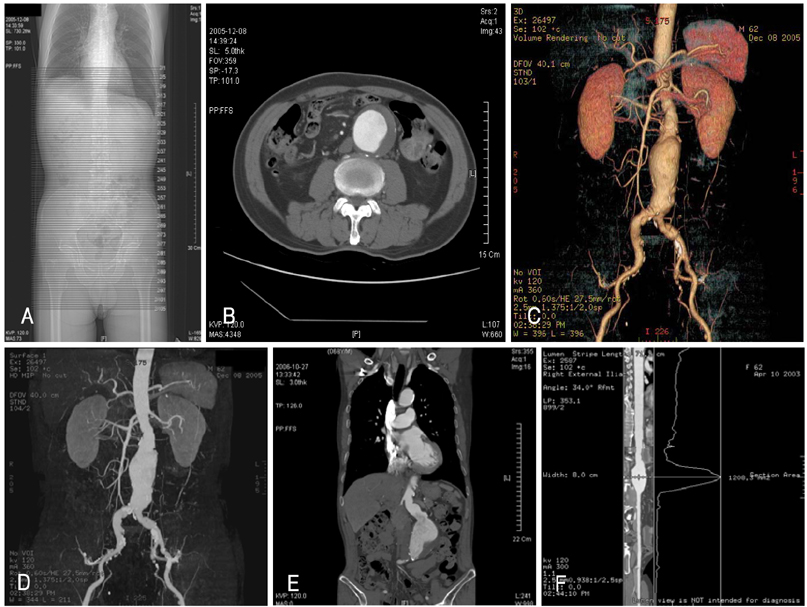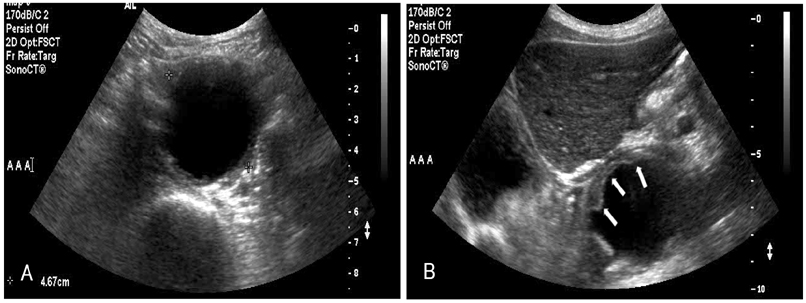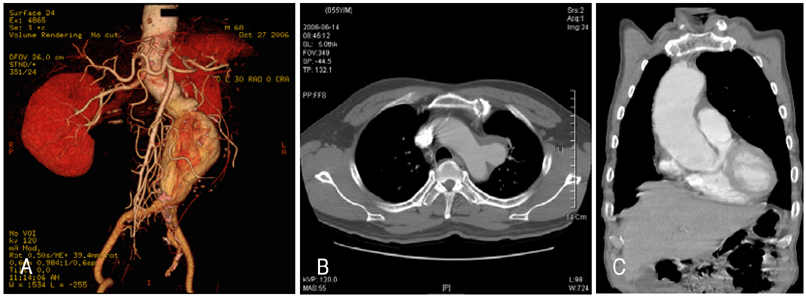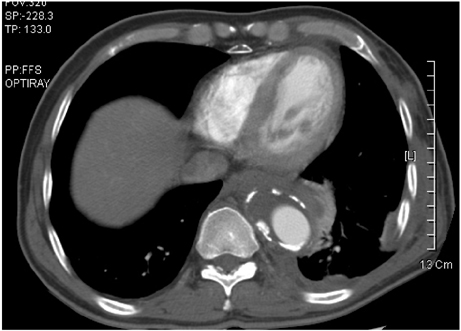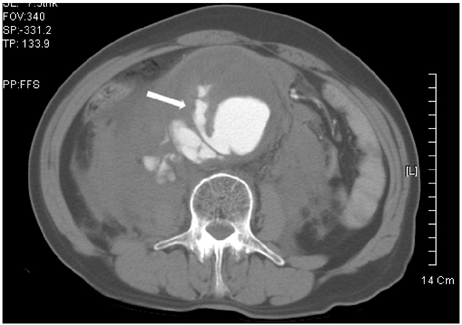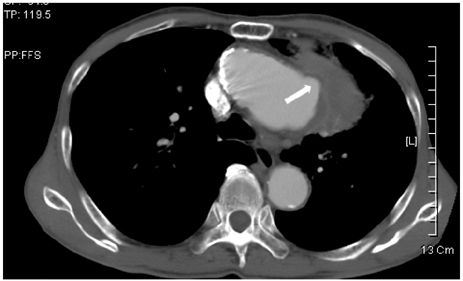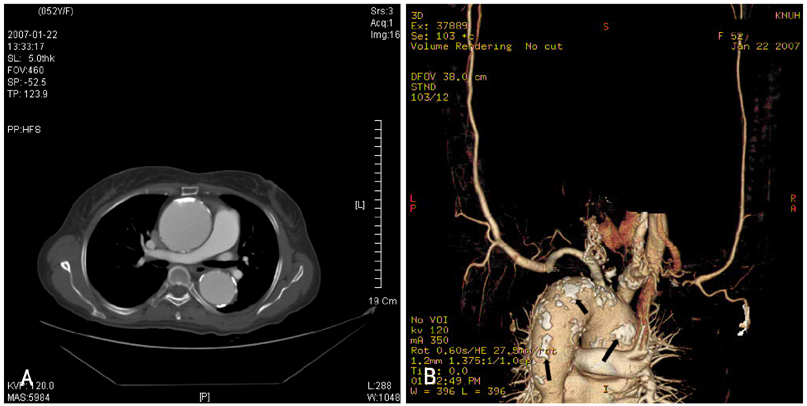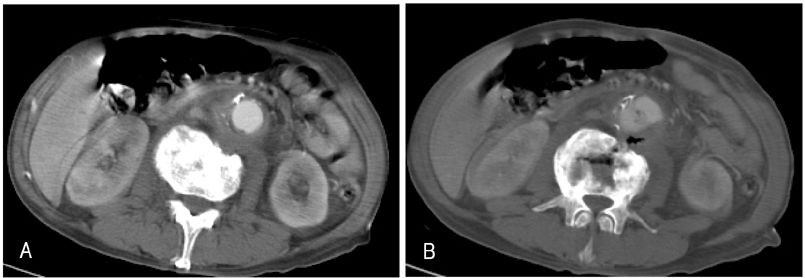Korean Circ J.
2007 Aug;37(8):337-345. 10.4070/kcj.2007.37.8.337.
Radiological Imaging of Aortic Aneurysms
- Affiliations
-
- 1Department of Diagnostic Radiology, Kyungpook National University Hospital, Daegu, Korea. jonglee@knu.ac.kr
- KMID: 2029060
- DOI: http://doi.org/10.4070/kcj.2007.37.8.337
Abstract
- The development of radiological equipment such as MDCT or ultrasonography has increased the diagnostic accuracy of aortic aneurysms and has allowed for improvements in surgical and interventional treatment techniques. However, the mortality and morbidity rate of aortic aneurysms has not decreased significantly. For this reason, there is continuous interest in radiological evaluations of aortic aneurysms. This report reviews the radiological image findings and useful indications for both the diagnosis and surveillance of aortic aneurysms. The popular radiological features of an aortic aneurysm are aortic expansion, combined atherosclerosis, intraluminal mural thrombus, perianeurysmal inflammation and fibrosis, and perianeurysmal hemorrhage due to rupture. As rupture is the most important complication of an aortic aneurysm, various signs of an impending rupture have been suggested. These include the following: a maximum aneurysmal diameter larger than the threshold value, a high expansion rate, periaortic sentinel hemorrhage, and a hyperattenuating crescent in the mural thrombus or aneurysmal wall. To acknowledge the impending rupture of an aortic aneurysm, careful depiction of the clues is indispensable.
MeSH Terms
Figure
Reference
-
1. Sakalihasan N, Limet R, Defawe OD. Abdominal aortic aneurysm. Lancet. 2005. 365:1577–1589.2. Sanfelippo PM. Abdominal aortic aneurysm-2003: what we know, what we don't know. Int J Angiol. 2003. 2:145–152.3. van der Vliet JA, Boll AP. Abdominal aortic aneurysm. Lancet. 1997. 349:863–866.4. McGregor JC, Pollock JG, Anton HC. The value of ultrasonography in the diagnosis of abdominal aortic aneurysm. Scott Med J. 1975. 20:133–137.5. Macura KJ, Corl FM, Fishman EK, Bluemke DA. Pathogenesis in acute aortic syndromes: aortic aneurysm leak and rupture and traumatic aortic transaction. AJR Am J Roentgenol. 2003. 181:303–307.6. Armerding MD, Rubin GD, Beaulieu CF, et al. Aortic aneurysmal disease: assessment of stent-graft treatment-CT versus conventional angiography. Radiology. 2000. 215:138–146.7. Anbarasu A, Harris PL, McWilliams RG. The role of gadolinium-enhanced MR imaging in the preoperative evaluation of inflammatory abdominal aortic aneurysm. Eur Radiol. 2002. 12:S192–S195.8. Mueller-Mang C, Wunderbaldinger P, Janata-Schwatzek K, Schoder M, Roegler M, Bankier AA. Acute dissection and contained rupture of a thoracic aortic aneurysm: emergency diagnosis with nonenhanced MR angiography. Cardiovasc Intervent Radiol. 2006. 29:930–933.9. Pereles FS, McCarthy RM, Baskaran V, et al. Thoracic aortic dissection and aneurysm: evaluaiton with nonenhanced true FISP MR angiography in less than 4 minutes. Radiology. 2002. 223:270–274.10. Quill DS, Colgan MP, Sumner DS. Ultrasonic screening for the detection of abdominal aortic aneurysms. Surg Clin North Am. 1989. 69:713–720.11. Catalano O, Lobianco R, Cusati B, Siani A. Contrast-enhanced sonography for diagnosis of ruptured abdominal aortic aneurysm. AJR Am J Roentgenol. 2005. 184:423–427.12. Siegel CL, Cohan RH. CT of abdominal aortic aneurysms. AJR Am J Roentgenol. 1994. 163:17–29.13. Defawe OD, Colige A, Lambert CA, et al. TIMP-2 and PAI-1 mRNA levels are lower in aneurysmal as compared to atheroocclusive abdominal aortas. Cardiovasc Res. 2003. 60:205–213.14. Yamazumi K, Ojiro M, Okumura H, Aikou T. An activated state of blood coagulation and fibrinolysis in patients with abdominal aortic aneurysm. Am J Surg. 1998. 175:297–301.15. Lindholt JS, Jorgensen B, Fasting H, Henneberg EW. Plasma levels of plasmin-antiplasmin-complexes are predictive for small abdominal aortic aneurysms expanding to operation-recommendable sizes. J Vasc Surg. 2001. 34:611–615.16. Mukaiyama H, Shionoya S, Ikezawa T, Kamiya T, Hamaguchi M, Saito H. Abdominal aortic aneurysm complicated with chronic disseminated intravascular coagulopathy: a case of surgical treatment. J Vasc Surg. 1987. 6:600–604.17. Wang XF, Liu L, Cheng TO, Li ZA, Deng YB, Wang JE. The relationship between intracariovascular smoke-like echo and erythrocyte rouleaux formation. Am Heart J. 1992. 124:961–965.18. Schurink GW, van Baalen JM, Visser MJ, van Bockel JH. Thrombus within an aortic aneurysm does not reduce pressure on the aneurysmal wall. J Vasc Surg. 2000. 31:501–506.19. Di Martino E, Mantero S, Inzoli F, et al. Biomechanics of abdominal aortic aneurysm in the presence of endoluminal thrombus: experimental characterisation and structural static computational analysis. Eur J Vasc Endovasc Surg. 1998. 15:290–299.20. Mower WR, Quinones WJ, Gambhir SS. Effect of intraluminal thrombus on abdominal aortic aneurysm wall stress. J Vasc Surg. 1997. 26:602–608.21. Wang DH, Makaroun MS, Webster MW, Vorp DA. Effect of intraluminal thrombus on wall stress in patient-specific models of abdominal aortic aneurysm. J Vasc Surg. 2002. 36:598–604.22. Thubrikar MJ, Robicsek F, Labrosse M, Cherrenkoff V, Fowler BL. Effect of thrombus on abdominal aortic aneurysm wall dilatation and stress. J Cardiovasc Surg. 2003. 44:67–77.23. Hans SS, Jareunpoon O, Huang R, Hans B, Bove P, Zelenock GB. Relationship of residual intraluminal to intrathorombotic pressure in a closed aneurysmal sac. J Vasc Surg. 2003. 37:949–953.24. Takagi H, Yoshikawa S, Mizuno Y, et al. Intrathrombotic pressure of a thrombosed abdominal aortic aneurysm. Ann Vasc Surg. 2005. 19:108–112.25. Satta J, L ra E, Juvonen T. Intraluminal thrombus predicts rupture of an abdominal aortic aneurysm. J Vasc Surg. 1996. 23:737–739.26. Stenbaek J, Kalin B, Swedenborg J. Growth of thrombus may be a better predictor of rupture than diameter in patients with abdominal aortic aneurysms. Eur J Vasc Endovasc Surg. 2000. 20:466–469.27. Vorp DA, Wang DH, Webster MW, Federspiel WJ. Effect of intraluminal thrombus thickness and bulge diameter on the oxygen diffusion in abdominal aortic aneurysm. J Biomech Eng. 1998. 120:579–583.28. Fontaine V, Jacob MP, Houard X, et al. Involvement of the mural thrombus as a site of protease release and activation in human aortic aneurysms. Am J Pathol. 2002. 161:1701–1710.29. Sterpetti AV, Hunter WJ, Feldhaus RJ, et al. Inflammatory aneurysms of the abdominal aorta: incidence, pathologic, and etiologic considerations. J Vasc Surg. 1989. 9:643–650.30. Walker DI, Bloor K, Williams G, Grillie I. Inflammatory aneurysm of the abdominal aorta. Br J Surg. 1972. 59:609–614.31. Hayashi H, Hidaka F, Kumazaki T, Ochi M. Serial assessment of the development of inflammatory abdominal aorticaneurysm from ordinary atherosclerotic abdominal aortic aneurysm usingmultidetector-row computed tomographic angiography. Heart Vessels. 2006. 21:334–337.32. Rasmussen TE, Hallett JW. Inflammatory aortic aneurysms: a clinical review with new perspectives in pathogenesis. Ann Surg. 1997. 225:155–164.33. Iino M, Kuribayashi S, Imakita S, et al. Sensitivity and specificity of CT in the diagnosis of inflammatory abdominal aortic aneurysms. J Comput Assist Tomogr. 2002. 26:1006–1012.34. Errington ML, Ferguson JM, Gillespie IN, Conal HM, Ruckley CV, Wright AR. Complete pre-operative imaging assessment of abdominal aortic aneurysms with spiral CT angiography. Clin Radiol. 1997. 52:369–377.35. Latifi HR, Heiken JP. CT of inflammatory abdominal aortic aneurysm: development from an uncomplicated atherosclerotic aneurysm. J Comput Assist Tomogr. 1992. 16:484–486.36. Kittredge RD, Gordon R. Inflammatory aneurysm of aorta: development documented by computed tomography. J Comput Tomogr. 1987. 11:128–131.37. Rozenblit A, Bennett J, Suggs W. Evolution of the infected abdominal aortic aneurysm: CT observation of early aortitis. Abdom Imaging. 1996. 21:512–514.38. Gayer G, Bass A. Delayed rupture of abdominal aortic false aneurysm following blunt trauma. Emerg Radiol. 2003. 10:64–66.39. Burke DR. Baum A, editor. Aneurysms of the abdominal aorta. Abram's Angiography: Vascular and Interventional Radiology. 1997. 4th ed. Boston: Little, Brown and Company;1079–1080.40. Jones CS, Reilly MK, Dalsing MC, Glover JL. Chronic contained rupture of abdominal aortic aneurysms. Arch Surg. 1986. 121:542–546.41. Zarins CK, Hill BB, Wolf YG. Townsend CM, Beauchamp DR, Evers MB, Mattox KL, Sabiston DC, editors. Aneurysmal vascular disease. Sabiston Textbook of Surgery. 2001. 16th ed. Philadelphia: W.B.Saunders;1357–1372.42. Mehard WB, Heiken JP, Sicard GA. High-attenuating crescent in abdominal aortic aneurysm wall at CT: a sign of acute or impending rupture. Radiology. 1994. 192:359–362.43. Siegel CL, Cohan RH, Korobkin M, Alpern MB, Courneya DL, Leder RA. Abdominal aortic aneurysm morphology: CT features in patients with ruptured and nonruptured aneurysms. AJR Am J Roentgenol. 1994. 163:1123–1129.44. Nevitt M, Ballard D, Hallet J. Prognosis of abdominal aortic aneurysms: a population-based study. N Engl J Med. 1989. 321:1009–1014.45. Limet R, Sakalihassan N, Albert A. Determination of the expansion rate and incidence of rupture of abdominal aortic aneurysms. J Vasc Surg. 1991. 14:540–548.46. Arita T, Matsunaga N, Takano K, et al. Abdominal aortic aneurysm: rupture associated with the high-attenuating crescent sign. Radiology. 1997. 204:765–768.47. Schwartz SA, Taljanovic MS, Smyth S, O'Brien MJ, Rogers LF. CT findings of rupture, impending rupture, and contained rupture of abdominal aortic aneurysms. AJR Am J Roentgenol. 2007. 188:W57–W62.48. Halliday KE, Al-Kutoubi A. Draped aorta: CT sign of contained leak of aortic aneurysms. Radiology. 1996. 199:41–43.49. Kieffer E, Chiche L, Bertal A, et al. Descending thoracic and thoracoabdominal aortic aneurysm in patients with Takayasu's disease. Ann Vasc Surg. 2004. 18:505–513.50. Takagi A, Tada Y, Ueno A. Greenhalgh RM, Mannick JA, editors. An extension of the classification of Takayasu's disease and the management of inflammatory aneurysm in Japan. The Cause and Management of Aneurysms. 2000. London: WB Saunders;213–219.51. Subramanyan R, Joy J, Balakrishnan KG. Natural history of aortoarteritis (Takayasu's disease). Circulation. 1989. 80:429–437.52. Macedo TA, Stanson AW, Oderich GS, Johson CM, Panneton JM, Tie ML. Infected aortic aneurysms: imaging findings. Radiology. 2004. 231:250–257.53. Gomes MN, Choyke PL. Infected aortoic aneurysms of the aorta: CT diagnosis. J Cardiovasc Surg. 1992. 33:684–689.54. Oderich GS, Panneton JM, Bower TC, et al. Infected aortic aneurysms: aggressive presentation, complicated early outcome, but durable results. J Vasc Surg. 2001. 34:900–908.55. Bennett DE. Primary mycotic aneurysms of the aorta: report of case and review of the literature. Arch Surg. 1967. 94:758–765.56. Perry MO. Infected aortic aneurysms. J Vasc Surg. 1985. 2:597–599.57. Aliaga L, Cobo F, Miranda C, Lara J. Mycotic aneurysm of the aortic arch. Infection. 2000. 28:240–242.58. Castaneda-Zuniga WR, Nath PH, Zollikofer C, Velasquez G, Valdez-Davila O, Edwards E. Mycotic aneurysm of the aorta. Cardiovasc Intervent Radiol. 1980. 3:144–149.59. Kaufman SL, White RI Jr, Harrington DP, Barth KH, Siegelman SS. Protean manifestations of mycotic aneurysms. AJR Am J Roentgenol. 1978. 131:1019–1025.60. Bennett DE, Cherry JK. Bacterial infection of aortic aneurysm: a clinicopathologic study. Am J Surg. 1967. 113:321–326.61. Baltacioglu F, Cunsit NC, Aribal ME. Tuberculous abdominal aortic aneurysm in a 14-year-old child. Pediatr Radiol. 1999. 29:536–538.62. Rozenblit A, Wasserman E, Marin ML, Veith FJ, Cynamon J, Rozenblit G. Infected aortic aneurysm and vertebral osteomyelitis after intravesical Bacillus-Calmette-Gue'rin therapy. AJR Am J Roentgenol. 1996. 167:711–713.63. Sueyoshi E, Sakamoto I, Kawahara Y, Matsuoka Y, Hayashi K. Infected abdominal aortic aneurysm: early CT findings. Abdom Imaging. 1998. 23:645–648.64. Yasuhara H, Muto T. Infected abdominal aortic aneurysm presenting with sudden appearance: diagnostic importance of serial computed tomography. Ann Vasc Surg. 2001. 15:582–585.65. Bower TC, Cherry KJ Jr, Pairolero PC. Unusual manifestations of abdominal aortic aneurysms. Surg Clin North Am. 1989. 69:745–754.
- Full Text Links
- Actions
-
Cited
- CITED
-
- Close
- Share
- Similar articles
-
- Hrombosed Aortic Dissections and Aortic Aneurysms: MRI Findings and Differential Diagnosis
- MR Findings of Thoracic and Abdominal Aortic Aneurysms: Comparison with Anglographic and Surgical Findings
- Aortic Arch Aneurysm: CT and MR Features
- Aortic Valve Sparing Operations: A Review
- Multiple Intracranial Aneurysms Associated with Interrupted Aortic Arch

